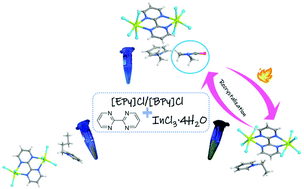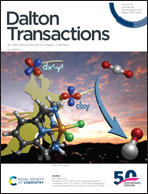Ionic indium(iii) chloride hybrids incorporating a 2,2′-bipyrimidine ligand: studies on photoluminescence and structural transformation†
Abstract
Although luminescent indium(III) based halide perovskites have been widely investigated, the study of emissive indium(III) halide hybrids is limited. Three indium(III) chloride hybrids based on a bpym ligand were synthesized, namely [EPy]2[InCl4(bpym)InCl4]·DMF (1), [EPy]2[InCl4(bpym)InCl4] (2), and [BPy]2[InCl4(bpym)InCl4] (3) (EPy = N-ethylpyridinium; BPy = N-butylpyridinium; bpym = 2,2′-bipyrimidine). They all exhibit a zero-dimensional structure, in which the ligand bpym interconnects two [InCl4]− to form a [InCl4(bpym)InCl4]2− anion that is further charge-compensated by the corresponding pyridinium cations. This is the first time using bpym to coordinate with an In atom. At 298 K, 1 exhibits a weak emission at 600 nm while 2 and 3 exhibit emissions peaking at 500 nm and 540 nm, respectively. Interestingly, the DMF solvent molecule in 1 can be removed by heating, thus resulting in the structural transformation of 1 into 2 together with a photoluminescence (PL) change. Density functional theory (DFT) calculations confirm that halogen-to-ligand charge-transfer (HLCT) occurs in the emission process. To the best of our knowledge, this is the first report on PL of ionic indium(III) halide hybrids incorporating organic ligands.



 Please wait while we load your content...
Please wait while we load your content...